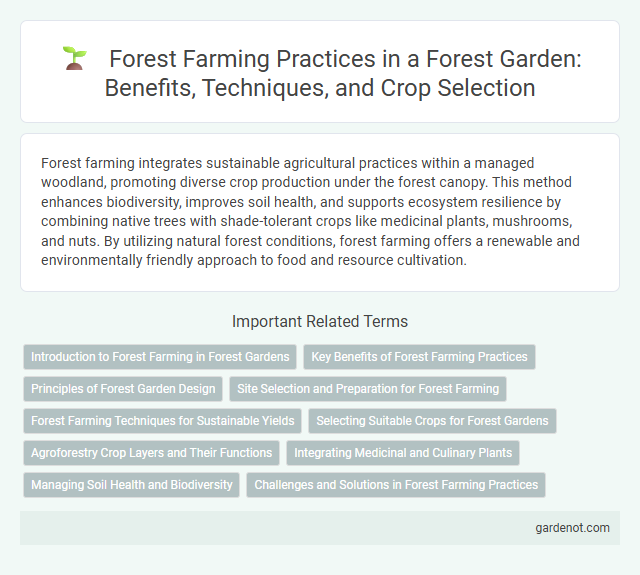Forest farming integrates sustainable agricultural practices within a managed woodland, promoting diverse crop production under the forest canopy. This method enhances biodiversity, improves soil health, and supports ecosystem resilience by combining native trees with shade-tolerant crops like medicinal plants, mushrooms, and nuts. By utilizing natural forest conditions, forest farming offers a renewable and environmentally friendly approach to food and resource cultivation.
Introduction to Forest Farming in Forest Gardens
Forest farming integrates cultivation of high-value crops beneath a managed forest canopy, promoting biodiversity and sustainable land use. It enhances ecosystem services by improving soil health, water retention, and wildlife habitats while producing medicinal herbs, nuts, mushrooms, and fruits. This agroforestry practice supports economic resilience for farmers through diversified income streams in forest garden systems.
Key Benefits of Forest Farming Practices
Forest farming enhances biodiversity by integrating diverse plant species within managed woodland areas, promoting habitat complexity and ecosystem resilience. This practice improves soil health through natural nutrient cycling and reduces erosion by maintaining continuous ground cover. Economic benefits include sustainable harvests of non-timber forest products such as medicinal herbs, nuts, and mushrooms, providing additional income streams while conserving forest resources.
Principles of Forest Garden Design
Forest farming integrates diverse perennial plant species to create a resilient ecosystem that mimics natural forest structures while producing food, medicine, and other resources. Key principles of forest garden design include layering vegetation vertically with canopy, understory, shrub, herb, ground cover, and root zones to maximize space and resource use. Selecting native and adapted species, promoting biodiversity, and ensuring sustainable soil management enhance productivity and ecological balance in the forest farm.
Site Selection and Preparation for Forest Farming
Selecting an optimal site for forest farming involves assessing soil fertility, drainage, sunlight exposure, and existing vegetation to ensure suitable growth conditions for desired crops. Preparation includes removing invasive species, enriching soil with organic matter, and designing sustainable planting layouts that mimic natural forest ecosystems. Proper site selection and preparation enhance crop yields, biodiversity, and long-term ecological balance in forest farming systems.
Forest Farming Techniques for Sustainable Yields
Forest farming techniques integrate agroforestry principles by cultivating high-value crops such as ginseng, mushrooms, and medicinal herbs under a managed tree canopy, promoting biodiversity and soil health. Utilizing shade management, selective pruning, and understory planting enhances microclimate conditions, optimizing growth and yield sustainability. Incorporating sustainable harvesting methods and soil conservation practices supports long-term productivity while preserving forest ecosystem functions.
Selecting Suitable Crops for Forest Gardens
Selecting suitable crops for forest gardens involves prioritizing shade-tolerant and perennial species that thrive under tree canopies, such as elderberries, pawpaws, and medicinal herbs like ginseng and goldenseal. Nitrogen-fixing plants like black locust and fava beans enhance soil fertility while supporting the diverse ecosystem. Integrating a mix of fruit trees, nut trees, and understory crops optimizes nutrient cycling and maximizes yield within the layered structure of a forest garden.
Agroforestry Crop Layers and Their Functions
Forest farming integrates multiple agroforestry crop layers, each serving distinct ecological and economic functions. The canopy layer, consisting of mature timber or nut trees, provides shade and habitat while producing valuable harvests. Beneath, the understory layer supports shade-tolerant medicinal herbs and shrubs, enhancing biodiversity and optimizing land use for diverse crop yields.
Integrating Medicinal and Culinary Plants
Forest farming enhances biodiversity by integrating medicinal and culinary plants such as ginseng, goldenseal, and ramps within shaded, managed forest environments. This agroforestry practice promotes sustainable land use, improves soil health, and creates diverse income streams for farmers by combining traditional forest crops with high-value understory plants. Optimal microclimates and selective harvesting methods ensure the long-term viability and potency of these valuable plant species.
Managing Soil Health and Biodiversity
Forest farming enhances soil health through diverse root structures that promote nutrient cycling and improve soil organic matter content. Maintaining a multi-layered canopy encourages habitats for beneficial microorganisms and pollinators, boosting biodiversity. Integrating native plants and minimizing soil disturbance supports long-term ecosystem resilience and productivity.
Challenges and Solutions in Forest Farming Practices
Forest farming faces challenges such as competition for sunlight and nutrients between overstory trees and understory crops, pest and disease management, and maintaining soil health amid diverse plant species. Solutions include selecting shade-tolerant crops, implementing integrated pest management (IPM) strategies, and applying agroforestry practices that enhance soil fertility through nutrient cycling and cover cropping. Effective monitoring and adaptive management help balance ecological interactions for sustainable forest farming productivity.
Forest farming Infographic

 gardenot.com
gardenot.com